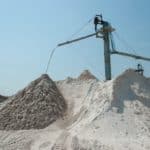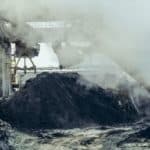Respirable Crystalline Silica Compliance – A New Standard Presents New Challenges
Insight IH Consulting is well versed in the assessment of respirable crystalline silica, and is very familiar with the new regulation that takes effect in June 2018. An active member of the American Foundry Society (AFS) Health and Safety Committee, Eric Pylkas has delivered many presentations on the topic of respirable crystalline silica. He has delivered talks at multiple two-day silica seminars, the AFS Metalcasting Congress, the AFS EHS Conference, the Federation of Environmental Technologist (FET) Conference, and local chapter meetings. He is also a published author in the peer-reviewed Metalcasting Transactions, having co-authored an award-winning paper on “An Advanced Method to Determine Root Causes of Exposure to Respirable Crystalline Silica in Foundries”.
Background
Crystalline silica is a prevalent mineral found throughout the earth’s crust. Sand, stone, concrete, and mortar all contain crystalline silica. It is also used to make products such as glass, pottery, ceramics, bricks, and artificial stone. Only very small particles, less than 4 microns, are of great concern from an exposure aspect. When silica is in this form, it is referred to as respirable crystalline silica.
Respirable crystalline silica – very small particles at least 100 times smaller than ordinary sand you might find on beaches and playgrounds – is created when cutting, sawing, grinding, drilling, and crushing stone, rock, concrete, brick, block, and mortar. Activities such as abrasive blasting with sand; sawing brick or concrete; sanding or drilling into concrete walls; grinding mortar; manufacturing brick, concrete blocks, stone countertops, or ceramic products; and cutting or crushing stone result in worker exposures to respirable crystalline silica dust. Industrial sand used in certain operations, such as foundry work and hydraulic fracturing (fracking), is also a source of respirable crystalline silica exposure. About 2.3 million people in the U.S. are exposed to silica at work.
Workers who inhale these very small crystalline silica particles are at increased risk of developing serious silica-related diseases, including:
- -Silicosis, an incurable lung disease that can lead to disability and death;
- -Lung cancer;
- -Chronic obstructive pulmonary disease (COPD); and
- -Kidney disease.
Regulatory Information
To better protect workers exposed to respirable crystalline silica, OSHA has issued two new respirable crystalline silica standards: one for construction, and the other for general industry and maritime. OSHA began enforcing most provisions of the standard for construction on September 23, 2017. Most provisions of the standard for general industry and maritime became effective on June 23, 2018. The new OSHA PEL for respirable crystalline silica establishes an OSHA Permissible Exposure Limit (PEL) of 50 micrograms per cubic meter (ug/m3) and an Action Level of 25 ug/m3.
Applicable OSHA Standard: 1910.1053 – Respirable crystalline silica.
Compliance Considerations
There are numerous requirements to stay in compliance with the silica standard. For employees over the Action Level, you will need to provide training and conduct future monitoring (at six month intervals, referred to as periodic monitoring) until concentrations of silica have been reduced. Medical surveillance and monitoring are necessary beginning in June 2020.
Compliance with the PEL is more involved. If an employer has workers with personal breathing zone results that exceed this limit, the employer needs to provide training, perform periodic monitoring (3 month intervals) until concentrations of silica have been reduced, provide medical surveillance/monitoring, provide respiratory protection, establish regulated areas (which require respirators), and institute controls (engineering/administrative) that will reduce the concentrations of respirable silica in the work environment. In addition to these requirements, common tools within many facilities (dry brooms and compressed air) are prohibited when they can contribute to employee exposures.
Quite a burden has been placed onto many firms by this new rule making. Insight IH Consulting can help you get your arms around the requirements of the program. First, we can provide baseline exposure monitoring and follow-up periodic monitoring services. There are scores of firms that can provide this service, some at absolute bargain prices. The old adage is “you get what you pay for”, which is a moniker that definitely applies to industrial hygiene services as well. In order to solve problems and lower concentrations (while remaining cognizant of cost), you need a comprehensive solution.
Product Offerings
Comprehensive Product #1 – Contaminant Mapping
– Do you need to establish a regulated area?
– Do you know the contributions of background respirable silica on worker concentrations?
– Looking to initiate a capital improvement project and would like to determine before/after concentrations for presentation to upper management (or to hold vendors accountable)?
Contaminant Mapping is your best best for all three of these. This involves using a real-time Aerosol Monitor to record data throughout a plant, then map those results over a site layout using AutoCAD and contour mapping software. The end product is extremely easy to communicate to employees and upper management, and is always well-received.
Comprehensive Product #2 – Root Causes Assessment
– Are you looking to determine the root causes of worker exposures (particularly those exceeding the PEL/Action Level)?
– Want to verify the effectiveness of your ventilation/engineering controls
– Interested in establishing feasibility for difficult to control processes?
Root Causes Assessment is an ideal solution to these questions. This offering involves the placement of real-time aerosol monitors in the employees breathing zone and in the background area. The instruments record hundreds to thousands of concentration measurements over a duration of time. The resulting data is then statistically summarized to provide insights into worker exposures that full-shift sampling absolutely cannot provide.
Comprehensive Product #3 – Ventilation Assessment
– Would you like to know how well your ventilation strategy is working to reduce worker exposures?
– Interested in determining the best course of action with regards to powered ventilation, such as the introduction of fresh-air supply or additional exhaust features?
– Do you know your ventilation requires upgrades, but don’t know where to start?
A Ventilation Assessment can help shed light on how well the equipment in place to protect your workers is performing. Many times, employers can significantly improve workers’ exposures with several inexpensive modifications to ventilation. In-duct traverse measurements, hood face velocity measurements, doorway/plant opening profiles, static pressure measurements, and baghouse/cartridge collector observations can all combine to paint a picture of the ultimate efficiency of your plant controls.
Summary
Of course, you can also opt to select a fourth option….all of the above! These products all readily integrate with one another, and in concert, they will provide tremendous knowledge of the actual conditions present within your facility. This information is critical for engineering and administrative controls (what good is an expensive exhaust hood if it doesn’t correct the actual problem), and will greatly assist in any dealings with OSHA (this level of data collection shows a dedication to correcting issues, and will put you in a good light).
Remember, crystalline silica is found in many products. The Insight IH Consulting article, “Beyond Sand and Stone – 10 Surprising Sources of Potential Respirable Crystalline Silica Exposure” touches on several of them.
Insight IH Consulting has extensive experience in personal sampling for respirable crystalline silica, and in compliance with the OSHA Standard.
Contact us for assistance with your crystalline silica compliance needs today!






